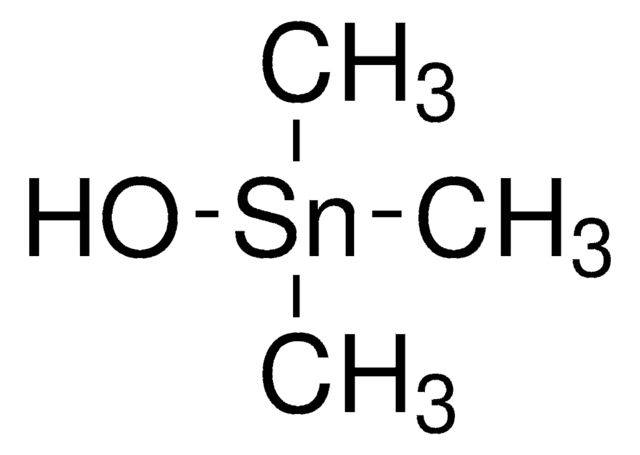Wichtige Dokumente
348104
Triphenylzinnhydroxid
Synonym(e):
Triphenylzinnhydroxid
Größe auswählen
Größe auswählen
About This Item
Empfohlene Produkte
mp (Schmelzpunkt)
124-126 °C (lit.)
SMILES String
O[Sn](c1ccccc1)(c2ccccc2)c3ccccc3
InChI
1S/3C6H5.H2O.Sn/c3*1-2-4-6-5-3-1;;/h3*1-5H;1H2;/q;;;;+1/p-1
InChIKey
BFWMWWXRWVJXSE-UHFFFAOYSA-M
Verwandte Kategorien
Anwendung
Reactant involved in synthesis of:
- (E)-(Nitrophenyl)propenoic acid organotin(IV) carboxylates with antitumor activity
- Triorganotin chrysanthemumates for larvicidal studies
- Polynuclear organotin(IV) carboxylates containing ferrocenyl moieties for antitumor investigation
- Organotin(IV) aminophenylacrylate complexes
- 4-Biphenylcarboxylic acid derivatives for in vitro cytotoxicity studies
Signalwort
Danger
Gefahreneinstufungen
Acute Tox. 2 Inhalation - Acute Tox. 2 Oral - Acute Tox. 3 Dermal - Aquatic Acute 1 - Aquatic Chronic 1 - Carc. 2 - Eye Dam. 1 - Repr. 2 - Skin Irrit. 2 - STOT RE 1 - STOT SE 2 - STOT SE 3
Zielorgane
Respiratory system
Lagerklassenschlüssel
6.1A - Combustible acute toxic Cat. 1 and 2 / very toxic hazardous materials
WGK
WGK 3
Flammpunkt (°F)
Not applicable
Flammpunkt (°C)
Not applicable
Persönliche Schutzausrüstung
Eyeshields, Faceshields, Gloves, type P3 (EN 143) respirator cartridges
Zulassungslistungen
Zulassungslistungen werden hauptsächlich für chemische Produkte erstellt. Für nicht-chemische Produkte können hier nur begrenzte Angaben gemacht werden. Kein Eintrag bedeutet, dass keine der Komponenten gelistet ist. Es liegt in der Verantwortung des Benutzers, die sichere und legale Verwendung des Produkts zu gewährleisten.
EU REACH Annex XVII (Restriction List)
Hier finden Sie alle aktuellen Versionen:
Analysenzertifikate (COA)
Die passende Version wird nicht angezeigt?
Wenn Sie eine bestimmte Version benötigen, können Sie anhand der Lot- oder Chargennummer nach einem spezifischen Zertifikat suchen.
Besitzen Sie dieses Produkt bereits?
In der Dokumentenbibliothek finden Sie die Dokumentation zu den Produkten, die Sie kürzlich erworben haben.
Active Filters
Unser Team von Wissenschaftlern verfügt über Erfahrung in allen Forschungsbereichen einschließlich Life Science, Materialwissenschaften, chemischer Synthese, Chromatographie, Analytik und vielen mehr..
Setzen Sie sich mit dem technischen Dienst in Verbindung.












